THE





What is your go to place to take a visitor in Columbia?

It really depends on the visitor and what their interests are. That’s the great thing about Columbia is that there are so many great and diverse options!
Top two though are probably a Mizzou football or basketball game and downtown for food and entertainment.
What’s your fave past time in Columbia?
Attending Mizzou sporting events.
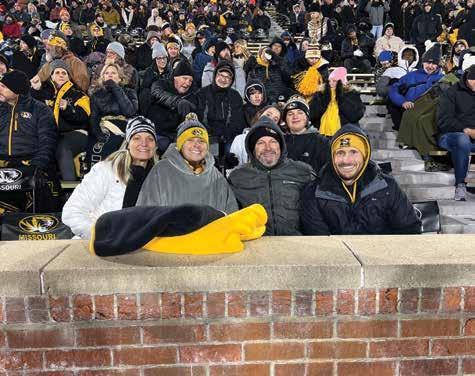
What do you think is Columbia’s best kept secret?
The great lineup of local and national music acts that come through Columbia.
How would you describe Columbia in one word?
Home.





If I were to sum up a wedding and event planner’s job in 2 words it would be “Chaos Coordinator”. I thought I had mastered that title as a wife and working mom to 4 kids but this career took that phrase to the next level.
I was used to having a back up plan as a mom of a newborn when you just knew that the second you were leaving Target your baby would have a full on blow out. I knew that I needed to check and recheck sports bags for everything that was required for the game or practice. I had mastered the art of running into the store to pick up the one ingredient that was forgotten (or previously consumed) for that night’s dinner.
But being an event planner is a whole different ball game. You have to think through the main plan, the alternate plan, the alternate to the alternate plan, a weather plan, an “oops we didn’t have enough” plan, the “I thought I had a plus one?” plan, and more.
All meticulously thought through so our clients don’t have to stress and all they have to do is show up and be a guest at their own event, have fun, and make memories to last a lifetime.
At Delight Events, we see ourselves as the ultimate partner in event planning and seek to create an experience unlike any other. We approach your event with high levels of attention to detail and communication and promise you’ll walk away not only as a favorite client, but also as a friend.

It is our goal to create delightful occasions that leave you with a full heart and memories to last a lifetime and specialize in one thing in particular; making your event stress free and fun! We welcome all kinds of couples, regardless of their sexuality, gender, race, religion, or body size and we work with guest lists, budgets, and events of all sizes that place a value on creating a quality guest experience.
We can’t wait to recap more of our lovely weddings from the past year and to celebrate with so many of you in 2023 and beyond!
VENDORS:
Planning: Delight Events

Venue: Walden Pointe Estate & Vineyard
Photography: Mitchell Bennett Photography
Floral: Buds Flowers
Gown: JM Couturiere
Vintage Rentals: Pretty Little Things

Rentals: A1 Party Event Rental
Suit: Men’s Wearhouse
Jewelry: Betz Jewelers
Cake & Desserts: Sugar, Butter, Flour
Cotton Candy: Coops Cotton Candy
Invitation Suite: On Three Designs















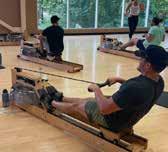






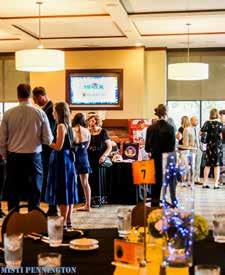






When Nevaeh was just a few weeks old, doctors at Children’s Hospital discovered she had a severe condition causing food to go into her lungs. Our pediatric aerodigestive team’s quick response not only spared her lungs from irreversible damage — it saved her life. Now, Nevaeh can just be Nevaeh. Learn more at muhealth.org/kids.
AKA: The Ball of Energy
We help kids be kids.
 Nevaeh
Nevaeh
Lombardo Homes is known for their quality, luxury, and customization in homebuilding. Lombardo is also known for their pricing transparency. Unlike most homebuilders, Lombardo Homes doesn’t rely on allowances and estimates to build your home. Instead, Lombardo takes each client through their trademarked Discovery Event™, learning about each client’s needs, pricing them accordingly, and presenting the client with the final purchase price BEFORE they sign a contract. The only thing that will change a client’s purchase price are options a client may add throughout the homebuilding process. Lombardo Homes clients are in full control of their purchase price before and during the construction of their new home!
Lombardo Homes is building in desirable communities in Columbia and Ashland, plus offers build-on-your-lot opportunities throughout the greater Columbia area. Contact our team to learn more!

573-542-0605 | lhcolumbia@lombardohomes.com | lombardohomes.com
ASHLAND, MO
Ranch and two-story homes from 2,100 - 3,800+ sq. ft.
Sales Office: 6380 Gateway Arch Way, Ashland, MO
ASHLAND, MO
Ranch and two-story homes from 2,100 - 3,800+ sq. ft.
Sales Office: 6380 Gateway Arch Way, Ashland, MO
YOUR LOCATION
Ranch and two-story homes from 2,100 - 3,800+ sq. ft.
Sales Office: 2871 Clopton Ct, Columbia, MO
COLUMBIA, MO
Ranch and two-story homes from 2,600 - 3,800+ sq. ft.
Sales Office: 2871 Clopton Ct, Columbia, MO
COLUMBIA, MO
Ranch and two-story homes from 2,600 - 3,800+ sq. ft.
Sales Office: 2871 Clopton Ct, Columbia, MO
COLUMBIA, MO
Ranch and two-story homes from 2,100 - 3,800+ sq. ft.
Sales Office: 2871 Clopton Ct, Columbia, MO
COLUMBIA, MO
Ranch and two-story homes from 2,300 - 3,800+ sq. ft.
Sales Office: 2871 Clopton Ct, Columbia, MO


















July 17 - 21, 2023
8:30am - 3:30pm
Ages: 11 - 14
This five day camp will provide middle-school aged kids a comfortable community space to watch films, learn about cinema, and participate in fun media workshops led by local professionals!



Ifit hasn’t already been abundantly clear in previous letters, my favorite job is being a mom. I have been blessed with the three most incredible kids. All three are incredible, but also so very uniquely di erent. I have one child who will not settle for anything less than perfect, one that lives by the “Cs get degrees” motto, and another that falls somewhere in between. I am very at peace with all three paths. I know that they will all reach exactly where they are meant to be, in the way they are supposed to get there.

I am con dent in where all three of them came from and the opportunities and support systems that have been instilled in them, all right here in good ol’ Columbia, MO. ey have had some of the most inspiring CPS teachers and mentors over the years. Two of them have already moved on to higher education, with the baby of the group following soon.
What I have really taken an interest and concern in over this past year is the mental health of our kiddos. We all have gone through life struggles. We have all had our moments growing up that weren’t easy. But we have never faced being a kid and being completely isolated for moooooonths. Away from our peers, away from society, our outlets, away from life as we know it. We are continuing to see the fallout and the huge impact COVID had mentally on our youth. I have personally witnessed this within my own relationships and have heard stories far and wide.
I am reassured to know that we have programs and organizations here locally that are taking great strides to support this global issue. You will read about

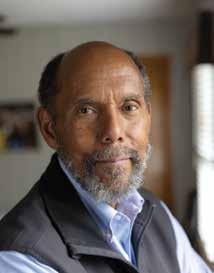

Compass Health in this issue, and we have covered our good friends at Burrell Behavioral Health multiple times. I know there are a lot of other resources out there as well. It is important to remember that you/we are not in this alone. If you or your kids are struggling, reach out to these places. Reach out to us. We will help you make the connections. It has to be okay to talk about. It has to be acceptable to admit that you are not okay and need help.
I will drop another shameless plug here for Young Life Columbia. is organization hands down has been one of the most life-changing, safe spaces for all three of my kids. e leaders of this group deserve more credit than I could ever give them. is program is for our high schoolers — they have weekly and monthly get-togethers, summer camps, and leaders who will meet your kids right where they are and truly invest in their lives. I have had the fortune of being involved with this program for years and would love to share more with anyone interested.
My email is always open. For story ideas, for help making connections, and for learning more about other organizations out there that fall into these categories. e kids are literally our future — let’s work together to create the best community we can for them!
President Erica Pefferman | Erica@comomag.com
EDITORIAL
Publisher | Erica Pefferman Erica@comomag.com

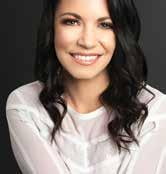
Editor-in-Chief | Kim Ambra Kim@comomag.com


Digital Editor | Jodie Jackson Jr Jodie@comomag.com
DESIGN
Creative Director | Kate Morrow Kate@comomag.com
Senior Designer | Jordan Watts Jordan@comomag.com
MARKETING
Director of Account Services
Amanda Melton Amanda@comomag.com
Marketing Representative Sarah Hempelmann Sarah@comomag.com
Marketing Representative
Becky Roberts Becky@comomag.com
CONTRIBUTING PHOTOGRAPHERS
Charles Bruce III, Lana Eklund, Madi Green
MARKETING
Director of Sales | Charles Bruce Charles@comomag.com

Director of Events | Scott Callahan Scott@comomag.com
OUR MISSION
To inspire, educate, and entertain the citizens of Columbia with quality, relevant content that reflects Columbia’s business environment, lifestyle, and community spirit.
CONTACT
The COMO Companies 404 Portland, Columbia, MO 65201 (573) 499-1830 | comomag.com @wearecomomag
SUBSCRIPTIONS
Magazines are $5.95 an issue. Subscription rate is $39 for 12 issues for one year or $69 for 24 issues for two years. Subscribe at comomag.com or by phone.

CONTRIBUTING WRITERS
Kim Ambra, Candice Ball, Alicia Belmore, Lauren Sable Freiman, Jodie Jackson Jr, Amanda Long, Michelle Terhune, Jennifer Truesdale, Emmi Weiner
We take pride in representing our community well and we couldn’t do what we do without our COMO Magazine advisory board. Thank You!
Beth Bramstedt
Associate Pastor Christian Fellowship Church
Kris Husted
Senior Content Editor NPR Midwest Newsroom

Heather Brown Strategic Partnership Officer Harry S Truman VA Hospital

Chris Cottle Walk Manager
Alzheimer’s Association Greater Missouri Chapter
Sam Fleury
Assistant Vice President, Strategic Communications, Columbia College
Alex George Owner Skylark Bookshop Executive Director Unbound Book Festival Author
Chris Horn Reinsurance Manager Shelter Insurance




Barbra Horrell Consultant Horrell Associates
Jeremiah Hunter Assistant Police Chief Commander Investigations Bureau Columbia Police Department
Amanda Jacobs Owner Jacobs Property Management




Darren Morton Program Director Turning Point
David Nivens
Chief Executive Officer Midwest Computech




Megan Steen Chief Operating Officer, Central Region Burrell Behavioral Health

Nathan Todd
Business Services Specialist First State Community Bank
Wende Wagner Director of Philanthropy The Missouri Symphony
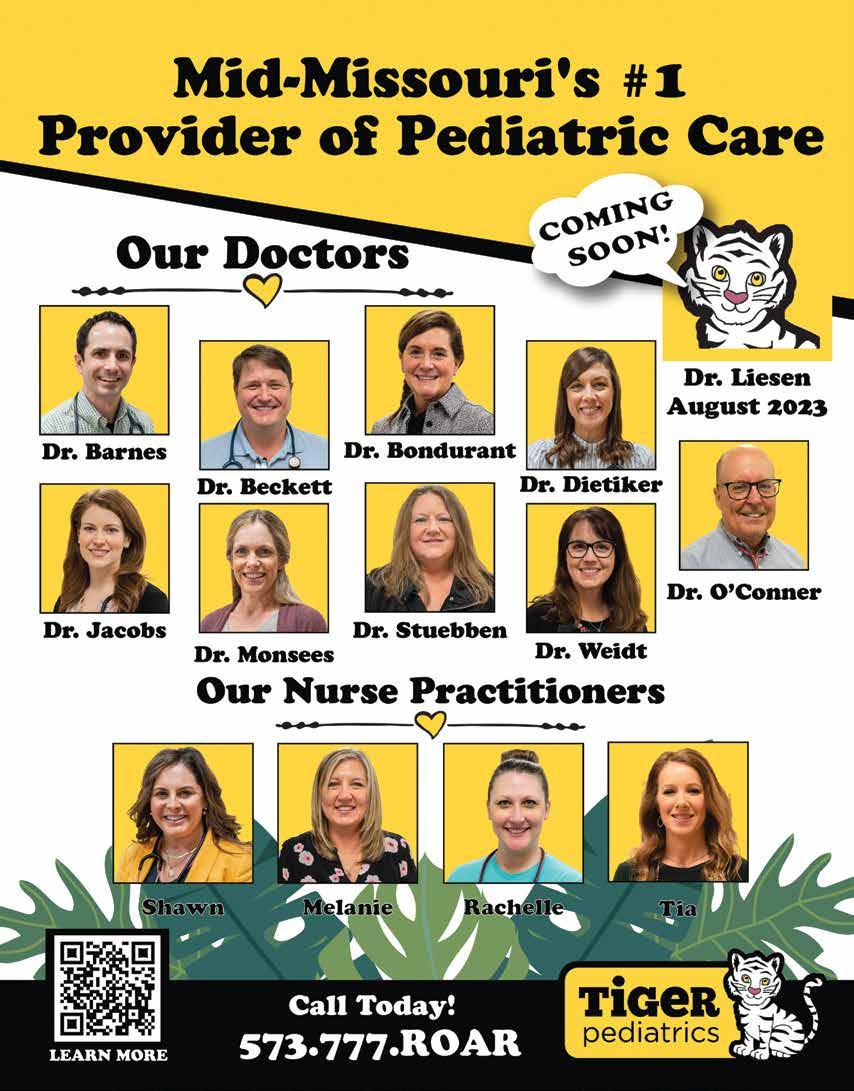
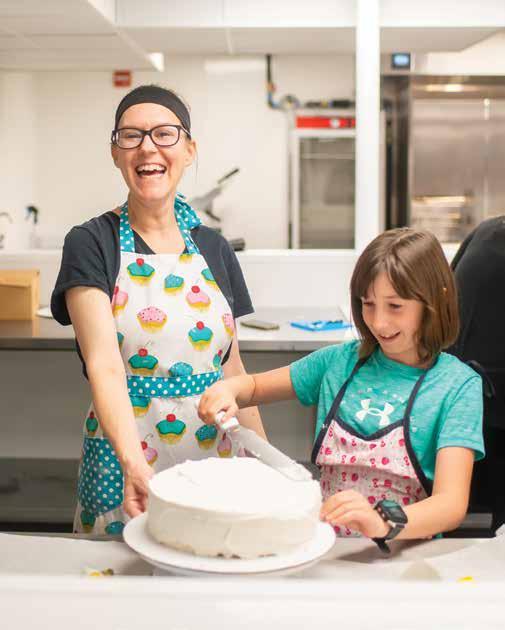

One of the best artistic options for kids has seemingly sprung up from underground in downtown Columbia.
Art Underground Downtown is a place for kids of all ages to go, learn, grow, and be themselves — a place where they can feel they belong and that they are a part of something. Founded eight years ago, the organization continues to grow.

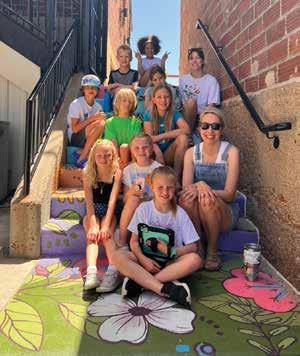
In 2015, Wendi Jensen was an art teacher in the Liberty, Mo., public school system. She began giving a few of her friends’ children private art lessons and as the number of students rapidly grew, Wendi realized she could provide private lessons on a full-time basis. She left the school district and focused her energy on the new endeavor.
Wendi's own artistic path began when she was a child.
"I grew up as the kid who saved every Hershey’s Kiss wrapper so I could add them to some art project," she says on her website. "I won coloring contests but stunk at any sport my parents had me try. My patient mother even let me paint all of my bedroom furniture and do chalk

art all over the basement's cement walls." Eventually, her mother connected Wendi with an adult oil painting class, and Wendi found the outlet she needed for her "trash-saving, creative self."
After moving to Columbia, Wendi decided to reopen, found a location in e Walnut Building at 1001 E. Walnut St., and named her business Art Underground Downtown. It's a place where children can go to learn about and appreciate all forms of art, and connect with others who are forming a passion for artistic expression. Wendi has seen it become that place where some children have found a place to t in, where they can build a community, feel comfortable, and return for new classes.
e programming focuses on children ages kindergarten through 12th grade. Classes are primarily in the evening after school, but some homeschool classes are o ered during the day. e curriculum is designed appropriately for each grade level, and the classes stay together with the same teachers for continuity. One example of classwork is zeroing in on one artist's work, learning about that artist's life and style of art, then practicing some of those styles and techniques.
All forms of art are practiced and taught in the classes: from basket weaving to painting, crafts and clay pottery, and even illustrations and drawing. Wendi employs other enthusiastic artists to help teach and recently added some adult classes to the roster. Expansion is ongoing as Art Underground Downtown has secured more space at its location, creating the ability to add more teachers, more adult classes, and more space to accommodate the rapidly-growing number of children attending.
Art Underground Downtown o ers summer camps, too. is summer's camps will have 330 spots, up from the 200 spots available last summer, and 283 spots have already been lled. e camps have scholarships available. ose who complete classes as children may come back after high school for a paid internship role if the students are interested in that opportunity.
e future looks promising for the growing community of Art Underground Downtown with expanding the space, teaching sta , and curriculum. Wendi's goal is "to be a light in Columbia for kids who love the arts and to be a good in uence for young people of our community.”
Wendi states on her website that being able to provide a venue for kids who love to create "has been ideally rewarding."
"Problem-solving, critical thinking, and using that right side of the brain are so important in forming young minds," she said. "I have seen such validation on the faces of my students when their work is shown in public and complimented. I love running into former students and seeing how they've grown artistically and made their way into design vocations."
Whether you're an employer looking to strengthen your workforce or an individual looking to advance in your career, the MU Career Accelerator is here to meet your needs.

• Self-paced or synchronous options
• Online or in-person options
• Continuing education hours available

• Noncredit courses

• Bootcamps
• Certifications
• Invest in your employees with our customized plans

Trotting down the halls of the University of Missouri Children’s Hospital, Link the therapy dog spreads joy and smiles to both patients and sta alike, a role he has lled as an essential member of the hospital's Child Life sta for four and a half years.

“ e longer he has been here he's more known and the more he's just recognized. I get stopped a lot, ” says Corinne Joplin, Link’s handler and a Child Life specialist. She has been with the hospital for 13 years and is the only handler Link has known.
“ ere’s just a lot of smiles no matter where you go when you have him with you,” she says.
Every afternoon, Link gets to work visiting patients in various departments, including oncology, the pediatric intensive care unit, hematology, and sometimes even the emergency room — as long as there is no respiratory illness present. (Link’s visits are sometimes limited due to infection control within the hospital. A child’s care team will keep patients informed if that happens.) Studies show that dogs help lower blood pressure and encourage a more relaxed disposition, and Link is a testament to that understanding by helping ease anxiety among patients.
“For those kids that are having a hard time sometimes it's just a way to kind of break down that barrier and help them relax a little bit and start talking,” Corinne says. “For lots of kids, it just brightens up their day.”
Link can also help children with mobility issues. ere is sometimes a feeling of shame associated with being sick or unable to move how one wants, but Link provides a calm, nonjudgmental presence that helps patients get the courage to overcome those feelings and make progress in their treatment. As a result of his hard work and comfort-ready presence, Link has earned himself a lit-
tle bit of a reputation and might even be considered a celebrity.
“We have a lot of kids that come here for spinal surgery with Dr. Hoernschemeyer and some of these kids travel really far. ere's a Facebook group they connect in," Connie explains with a laugh. "And they all know about Link. So they inevitably always ask about seeing Link, which is pretty cute.”
With paws that reach across more than just patients, Link is an essential team player who even helps the sta when there are tough days. It's no secret that working in a hospital is an emotionally taxing job, but Link is able to provide comfort for those providing care.
“If there is a death of a kiddo, sometimes we try to wander up to that unit and just give the sta a little extra love,” Corinne adds. “We have something called the 'For You Team' here at the hospital where we debrief after the death of the patient and when possible, we try to include Link in that because again, it's just that nonjudgmental support.”
Link comes from Duo Dogs, an organization based in St. Louis. Duo Dogs trains canines to become assistance dogs, facility dogs (like Link), or touch therapy dogs. Once dogs are fully trained, their handlers come and participate in a week of training on how to be a handler. Dogs go through a recerti cation process once a year.
Corinne also makes sure Link is primped and presentable. "We have to brush his hair every day," she says. "We give him a quick once-over to make sure there's no injuries and just to make sure he's healthy."
Corinne hopes that the program will continue to grow and be funded. If a patient at Missouri Children’s Hospital would like to request a visit from Link, they can mention it to their nurse, doctor, or child life specialist.
“There’s just a lot of smiles no matter where you go when you have him with you.”
CORINNE JOPLIN Child Life specialist, University of Missouri Children's Hospital





Compass Health Care provides accessible resources to families in their own neighborhood.
Compass Health Network adopts a person-centered, integrated approach to health care that focuses on treating the whole person. at description sums up the nonpro t healthcare organization's approach to providing resources connected to behavioral health, pediatric and family medicine, dental care, and treatment for substance use disorders.
“Our vision is healthy, productive lives for everyone,” says Karen Cade, regional vice president of corporate services for the Compass Health Network, Central Region. e organization serves more than 42 Missouri counties. Compass Health provides medical, dental, and behavioral health services in Columbia, which include therapy, psychological testing, psychiatry, and substance abuse disorder treatment.
BY CANDICE BALLKaren describes her role as a liaison to the community, as well as providing oversight to the company's general culture, which includes overseeing outside projects and collaborations. She connects people to make sure their various projects are completed. She also works with sta to complete the “Champion Training” program to ensure that all of the team understands what it means to be a “Compass Champion.” That training helps encourage each sta member to understand their individual role, and how that role works in service to the community that can bene t from what Compass provides.
Karen wears a lot of hats for the rapidly-growing Compass Network.
“For example,” Karen says, “I work with the local United Way in Je City and Columbia. In Columbia, we have United Way
funding and we have some county funding to provide school-based therapy.”
Compass is close to completing a new o ce o Keene Street.
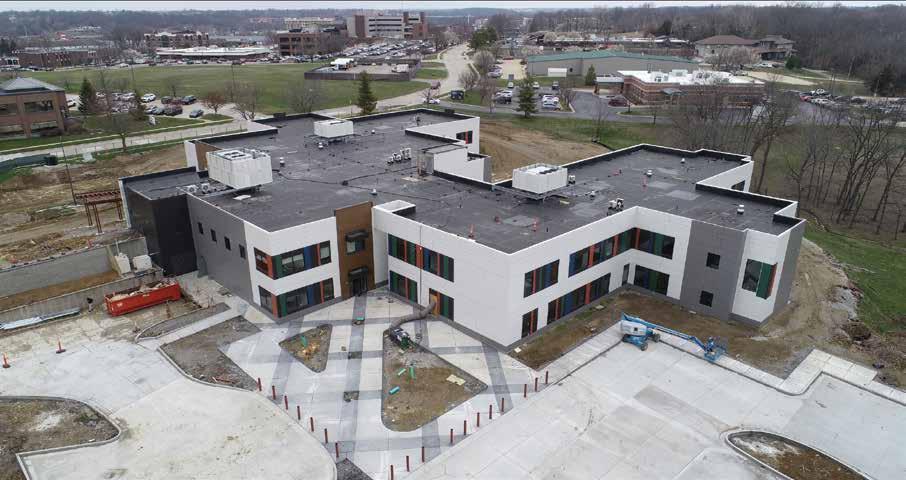
“In the last year and a half, we opened an o ce over across from Boone Hospital, which o ers both primary care and pediatric services at that location,” Karen says. “We’ll be moving our pediatric services to our new building, to the new Portland project, but we’ll continue to provide primary care services at that location.”
Some dental services will move to the ofce on Keene Street and the o ce on Providence Road will become an express care center for both medical and dental services.
e need is really there for that kind of care, she adds, noting that the Compass mission is focused on meeting that need.
“We’re a federally-quali ed health care center, so what that means is, we’re re-
quired to serve people, regardless of their income, regardless of their insurance status, and we have several di erent methods of doing that, depending on what the service is,” Karen says. Compass Health accepts most of the major health insurance plans as well as Medicare and Medicaid.
ere's also a sliding scale option for payment based on income.
For mental health services, Karen says that Compass o ers a number of resources, including counseling and psychiatry for children and adults, telehealth, transcranial magnetic stimulation, psychological assessment and testing for children and adults, psychology services, and school-based therapy.
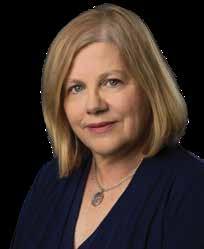

“On the behavioral health side, we have some city funds that allow us to pay for direct therapy services for persons that may be uninsured and might not meet income guidelines, so we have di erent types of funding for people who may not have insurance,” she adds.
Within the last six months, Compass has provided service for helping individuals and families access Medicaid.
“If we see that they’re quali ed” based on income "and we think they qualify, we have the ability to do what’s called presumptive Medicaid, so we will be able to give them Medicaid for 30 days by the time they walk out the door.”
e ability to access health care without nancial barriers is an important function of Medicaid.
Karen also says that helping provide clients access to Medicaid
doesn’t just help them access services at Compass. It helps clients access services at other clinics. In addition, Compass is expanding access to dental services, especially for pediatric care. Compass’s Broadway location provides walk-in pediatric dental care on Mondays, Wednesdays, ursdays, and Fridays, and has same-day access for service.
“When we’re at our new building, we plan to continue providing those services,” Karen says. Compass also provides a mobile dental unit that visits schools throughout the region. Compass is working with Columbia schools to make sure the full gamut of care is available on-site in the school parking lot within the next school year.
Karen says Compass wants to continue to identify and respond to what the community needs for all facets of healthcare.
“We want to serve more people,” she explains. “When there’s a need: we want to continue to meet that need. We want to ensure that the whole person is treated.”
She describes how Compass provides the “whole person” approach.
“ e physician may be the one to identify the dental needs. e dentist might be the one who determines that the person has behavioral health needs,” Karen adds. “We want to get those connections made — and get that need met all in one location.”
“Our vision is healthy, productive lives for everyone.”
KAREN CADE Regional Vice President of Corporate Services for the Compass Health Network, Central Region
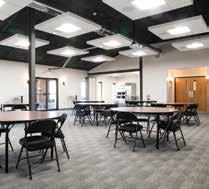
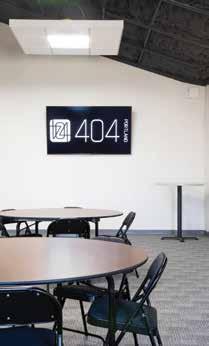






It’s important for our community to know that Columbia Public Schools is focused on achievement and believes in high expectations for its scholars.
In a period of time that has been politically charged and critical of public schools, I’d like to share with you an experience I had at Derby Ridge Elementary School. I shared this same story with CPS employees earlier this school year.
During my visit to the school, I met a scholar who was excited to show me the di erent ags they were learning about. He showed me the ag of the country he came from — Libya. He was proud to show me what he was learning about different countries.
As many of you may know, I'm originally from Trinidad and Tobago. I showed him the ag from Trinidad and Tobago. I showed him where it was on the globe. We had an immediate connection about being from di erent places and a shared similar experience of coming to a new place and feeling welcomed and encouraged.
We shared di erences and similarities. In a world where people have di erent beliefs, cultures, and values, nding common ground can be challenging.
is scholar and I were able to build a bridge by nding common ground in a shared experience. Finding common ground establishes a sense of unity and establishes a deeper understanding and respect for one another. Similarly, recognizing and understanding di erences can lead to increased empathy, grace, respect, and appreciation for each other's unique qualities.
Finding common ground through similarities and di erences requires open-mindedness and a willingness to listen. People must be willing to put aside their preconceptions and biases to truly understand and appreciate the perspectives of others.
We are at a pinnacle point in time in our district. We are faced with the challenge to build on the successes and address opportunities for improvement.
We must identify common ground with our critics and create unity through our shared goal of putting scholars rst. We must lean into the di cult conversations to move the achievement needle.
I'm going to lean into the discomfort, have the di cult conversations, and accept the challenge of those who believe we can't do it. I believe that if there is any district in the state that can raise the achievement bar, it's CPS. is is a great district with outstanding, high-quality educators, sta , and administrators. We're up to the challenge.
As superintendent, I also ask for the community’s support and encouragement to help us get there.
Brian Yearwood is the Superintendent of Columbia Public Schools
Imagine that you are a young woman who is unexpectedly pregnant. You are homeless, lack education, and cannot turn to the father or your family for support. What do you do?
Where do you go?
ere aren’t many options, but St. Raymond’s Society is changing that. St. Raymond’s Society (SRS) is a maternity home with headquarters in Columbia, plus a home in Je erson City.
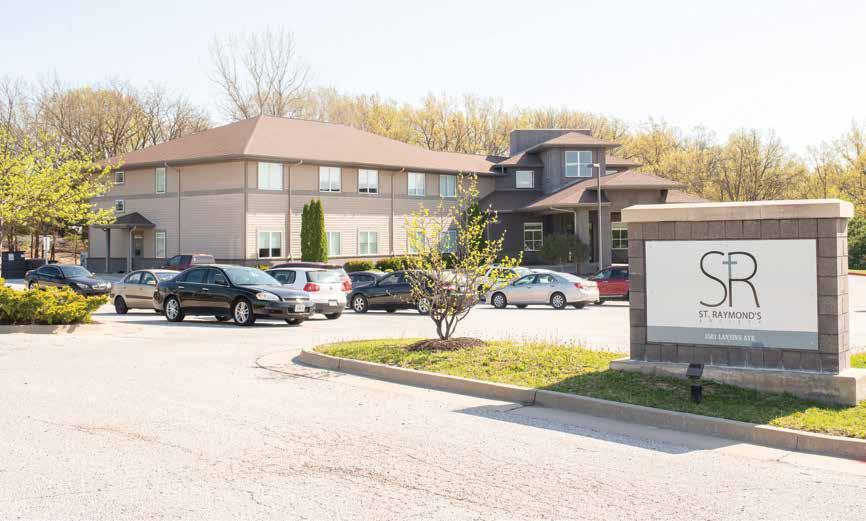
ere’s a good chance you’ve never heard of this organization — SRS chief executive o cer and co-founder, Mike Hentges, says St. Raymond’s has own under the radar since opening in 2010, because, while news of the opening brought in donations, it also attracted more clients than they could serve.
What is a maternity home? is residential facility provides a home to expectant and new mothers who have nowhere else to turn. Mike says most of the women served have no place to
live and are not able to count on support from the child’s father or family members. And most of the women are also working to overcome some kind of trauma. eir lives are complicated, and with a baby on board, they’re about to get more complicated. ese are the women SRS serves, and it all started 20 years ago when Mike had what can best be described as a divine calling to serve this population.
SRS is an interfaith organization, but it is rooted in Christian values and the idea that “with God is better than without.” It operates with 10 full-time sta and three part-timers.
“We feel like we’re saving the mother from a rough road ahead,” Mike explains. “We’re mother-focused. We love babies, but we’re really focused on the mother and giving her the support she needs because if we take care of mom, baby is going to be just ne.”
St. Raymond’s Society provides a safe haven for mothers who have nowhere else to turn.


In 2000, Mike was invited to Washington, D.C., to chaperone students attending the annual pro-life March for Life rally, when he was struck with a thought.
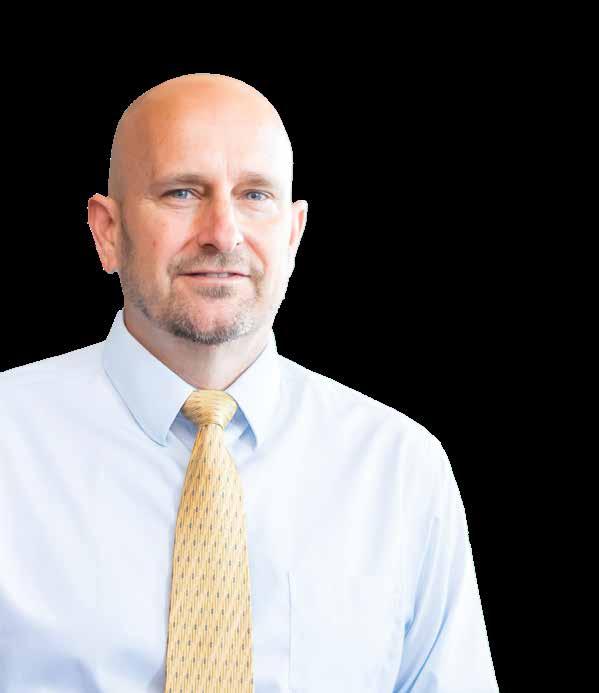
“Coming back from that trip I found myself thinking about this issue [of mothers going unsupported] and what if the law about abortion were to change — and I never really thought it would change — how many women would need help after the baby is born?” Mike remembers. “ at was what kept coming back to me — I can see help for women who face unplanned pregnancies and don’t have support, I can see the help for them during the pregnancy, but who is helping them afterward when the going gets tough and they can’t turn to the father or to family for support? Who is there to stand with them at that time?”
At the time, Mike was content with his career and life. He and his wife, Jami, have four children. Mike, now 49, started working at a golf course after college, then decided to open his own business installing and maintaining sprinkler systems. He did that for 10 years before merging with Columbia Lawn Care, a company he was with from 2010 to 2020, working his way up to become company president.
Mike wasn’t looking to make a change. But he says for eight years after that trip, the thought of how to help unsupported mothers kept bubbling up. He hoped someone would do something.
“And then a small thought popped in my head: ‘Why not you, Mike?’” he recalls. “And I thought, ‘Nope, not me.’ For eight years I tried to wrestle that thought out of my head because I didn’t have the time, the availability, or the know-how. I didn’t know why this thought kept coming to me — I’m perfectly happy with my career and my family.”
In 2010, Mike surrendered to that calling to serve. Mike wanted to honor his parents in the name of the organization; he decided on St. Raymond’s because his father is Ray Hentges. Ray was the head football coach at Helias High School in Je erson City for 33 years, and the school’s stadium is named for him.
Having grown up Catholic, Mike didn’t know of any Saint Raymonds in history, but a Google search quickly yielded some uncanny results: Mike found that a Saint Raymond Nonnatus lived in 13th-century Spain and was none other than the patron saint of unborn children.
“It was very eerie, but rea rming; God’s telling me to trust him and take that rst step, and we’ve been walking on faith ever since,” he explains, adding, “Steve (Smith) got the ball rolling” by suggesting putting some resources together and approaching local pregnancy resource centers to invite them to refer mothers to them.
“In the beginning, it was just Steve and me working with these young mothers,” Mike says.
ey were able to secure two, four-bedroom homes in those early days — one in Je erson City and one in Columbia — and they served 12 to 15 women per year. For the rst 10 years, SRS had no full-time executive director or CEO with Mike and Steve devoting their spare time to the project. Mike moved into the CEO role in 2020.
“I’ve heard it before, and I believe it: Sometimes you don’t choose your destiny, your destiny chooses you,” Mike says with a smile.
“We e mother-focused. We love babies, but we e really focused on the mother and giving her the support she needs because if we take care of mom, baby
In January, SRS moved into the former Ronald McDonald House Charities home at 3501 Lansing Avenue o Keene Street. To make things even better for the small SRS team, the facility was sold fully furnished, including the playground equipment.


e enormous building is less than a decade old, and its tall facade is a little intimidating until you walk inside. A homey lobby welcomes guests just inside the door. A bath of natural light from the second- oor windows enhances the welcoming vibe. Opposite the lobby is the entrance to a big kitchen, cozy communal dining space, and an outdoor play area that is fenced in and complete with a jungle gym. ere also is access to a trail that leads to a city park and a soccer eld.
A hallway between the lobby and kitchen areas leads to a sta space. In a little alcove in that hallway are portraits of Mike’s and Steve’s parents.
“ is wouldn’t be happening if it wasn’t for how they raised us,” Mike explains. “Because of my upbringing, I learned that my life is not for me, but for those around me. is somehow led me to
place myself in the shoes of a young mother who was scared and had no support. From that empathy, St. Raymond’s was born.”


e largest part of the building contains two stories of bedrooms for its residential clients. ere are 18 rooms in total, and women may stay in a room with up to three children under the age of 5 for up to one year. is number of rooms will allow SRS to double the number of moms served each year, at a minimum. Currently, 10 mothers are living there. Mike says they didn’t want to fully book the new facility while they’re still working out kinks, but they have enough applications to be full tomorrow.
e rooms are a little bit bigger than a college dorm room, comfortably appointed with a double bed, a dresser, and a wing chair. ere is room for a single bed or crib for a child. Each room has its own bathroom, and two big windows let in light and look out onto the surrounding wooded area. e second oor includes a fully stocked rec room for kids and a small chapel.
“Women live here rent-free, and most of them are working part-time jobs, which allows them to save at least half of what

they make while they’re with us,” Mike says, adding that not having to worry about bills for a full year gives the women a chance to hit reset at a critical time and to work on self-sustainability.
SRS isn’t just a hotel for mothers in need. e organization o ers three programs: Residential Client, Community Client, and Temporary Assistance.

e Residential Client program is for the women who live on-site, while the Community Client program is for women who have their own homes, but there is no di erence between the self-su ciency coaching services these two receive.
“It’s always been about coaching the women into acquiring what they need,” Mike says. “ at coaching centers around four meetings they have per week; two are individual, two are group sessions.”
e one-on-one sessions focus on life goals, while the group sessions address how to manage the smaller steps needed to achieve those life goals. e sessions are led by volunteers. If more intensive counseling is needed, clients are referred to Burrell, which luckily, is within walking distance.
“And we really stress getting some kind of education or job training that will command a higher salary,” Mike adds. “Because you have to be able to make enough money to support yourself and your child.”
e Temporary Assistance program is for clients who have hit a nancial speedbump in life — a health crisis, a broken down car, or a job loss. Clients may apply for nancial assistance once a year. SRS is completely funded by private donations.
In yet another turn of fortune, Mike discovered that a building a few steps away from SRS was available for lease. He inquired with the owner about opening a preschool there, and SRS is working to open that facility August 1.



“ e space was previously a medical ofce,” Mike says. “We’ll be able to serve 80 kids — 20 spaces will be reserved for St. Raymond moms — and the other 60 will be open to the public. [SRS] moms will pay on a sliding scale.” is will meet another community need while adding a revenue stream for SRS.
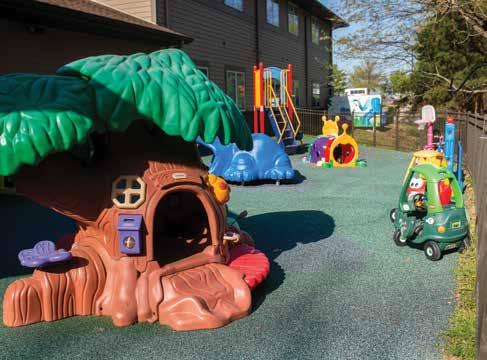


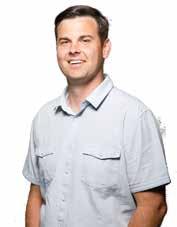
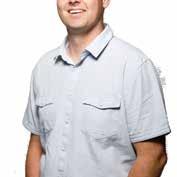
The month of May is all about the build-up to summer fun, but first, there are celebrations and gatherings for the graduates. Columbia will be graduation-central with multiple high schools and colleges honoring their students with diplomas and degrees.
Is your home ready to host one of those gatherings in a small, intimate setting or with a house full of guests?
Baumgartner’s can help you get your home ready to celebrate those milestones. If you’re visiting online, in the store, giving us a call, or having an online chat with one of our furniture experts, you can explore how Baumgartner’s is best suited and qualified to meet your furniture needs.
Looking at the living area, let’s check out selections from the La-Z-Boy Comfort Studio for sectionals, a console bar, three stools living room groupset from Liberty, and a console bar and three stools living room groupset from Liberty, and then a sleeper sofa. Living room seating comes in a variety of styles and trusted brands, from Ashley to Flexsteel, Bassett, and of course La-Z-Boy.
FOR SECTIONALS, consider the Reese sectional from La-Z-Boy, a fantastic option for seating without overwhelming the space. The casual style sectional comes in a variety of pieces to be configured to any room or shape.
Adorned with single-needle topstitching on the arms, leg rest, seat, and back, the Reese sectional has a casual design that brings family-sized comfort to any room.

Jake essentially grew up in the furniture industry, as he is the fourth generation involved in Baumgartner’s Furniture. Working very closely with his father, Alan, Jake has been devoted to the stores full-time since 2004. His greatest enjoyment, however, still comes from working closely with the customers. He is married to Sarah, and they have two active boys, Noah and Laine. Jake received his degree in finance from Saint Louis University.
(573) 256-6288
BAUMGARTNERS.COM

Reese features ultra-comfortable pillow top arms and a tall, pub-style back that provides ample support for your head or neck while you relax or watch TV.
Customize yours with a wide array of fabrics and available upgrades.
• You’ll fall for the four-piece Liberty’s Parkland Falls Collection set, with three Uph console stools and the matching console bar table that works great behind the sofa.
• The essence of urban living furniture is its unique ability to fit many different styles: Rustic, casual, and contemporary. The console bar table can be used for a laptop or a snack while watching your favorite shows featuring two power outlets, two USB ports, and a cushioned upholstered seat in an Oatmeal color fabric.
• The console bar is constructed of pine solids with knotty pine veneers and a weathered taupe finish. The stools are upholstered in linen.
What about the extra or unexpected overnight company? Rather than having the
awkward experience of turning away one or two guests because the bedrooms are at capacity, a sleeper sofa may be the solution. La-Z-Boy’s Leah Queen Sleep Sofa is both stylish and versatile, a head-turner that provides the perfect place to later put that head on a pillow.
Timeless and on-trend, it features a sophisticated look that blends easily with your existing pieces. Its curving rolled arms, welt trim, and patented ComfortCore® cushions deliver just the right amount of comfort and support for a short or a long sit. And, overnight guests will love the Queen size Supreme ComfortTM quilted innerspring mattress.
In previous articles, Baumgartner’s has helped you understand our white-glove delivery service; some of our most popular brands for the living room, bedroom, and entertainment area; then a helpful primer on TV consoles and the ABCs of mattress shopping. Each step along the way, whether you’re reading this feature, browsing our products online, or visiting in person, you’ll see a continued emphasis on the fact that Baumgartner’s gives the feel, value, and inventory of a “big city store” — without having to drive to the big city.
Here in mid-Missouri, there are many pests to watch for in your landscape but “deer resistant landscape” is a phrase we hear day in and day out. If you’re tired of fighting the deer in your landscape and feel like giving up, we get it. But there are many plant choices to consider that deer usually leave alone. “Deer resistant” is not the same thing as “deer proof.” With deer resistant plants you should have better luck, but we can’t guarantee that some deer might be an exception to the rule. There are more options than you think so we’re going to talk about a few of our favorites.
Shade Shrubs:
If you’re looking for some plants for the north or east side of your home, you’ll want to check out our shade shrubs.
• Fothergilla: You’ll get three seasons of interest with spiky white fragrant spring blooms, blueish green summer foliage, then outstanding fall color.
• Red Twig Dogwood: This is a great opportunity to add some winter interest to your landscape with its bright red stems.
• Weigela: There are a few different types of weigela prized for their bright spring blooms and dark foliage.
Sun Shrubs:
These are historically deer resistant shrubs that are proven to be Missouri-hardy and can handle afternoon sun.
• St. John’s Wort: this beautiful plant with its blue foliage and bright yellow blooms is also great for pollinators.
• Ninebark: There are a bunch of different size and color options that you can choose from to best suit your location or preferences.

Kelly McBride grew up in Columbia just down the road from Rost Inc., and she's happy to still call Columbia home. She has a degree in plant science and landscape design from MU and was hired as Rost’s landscape maintenance manager after graduation. Her love for plants makes this job very enjoyable when assisting clients with their outdoor tasks. Outside of work, you can find her cooking, gardening, sewing, or doing other outdoor activities.
• Viburnum: My favorite is the Korean Spice Viburnum because the fragrance on these plants is amazing but there are many varieties of viburnums that you can check out.
Evergreens:
Evergreen shrubs are a necessity for any landscape and here are three excellent choices for a yard that must take deer into consideration.
• Common Boxwood: their classic shape can be used universally in landscapes and does well in both shade and sun.
• Junipers: This is a fun opportunity to select a different foliage color, whether you want yellow, blue, or green.
• Mugo Pine: if you’re looking for a rounded form, but with little to no maintenance, this is your evergreen.
Perennials:
There’s a lengthy list of perennials (both shade and sun) that can stand up to deer but here are a few examples.
• Columbine: a beautiful early springbloomer available in a variety of colors and ideal for shady locations.
• Astilbe: another shade perennial that comes in a wide range of colors. It will
flower in late spring and its wispy, cloudlike blooms are super fun.
• Salvia: we love salvia even if you don’t have a deer problem. Due to its fragrance, deer tend to steer clear of this one. Other scented plants such as Nepeta would accomplish the same goal.
• Dianthus: this super bright, petite little perennial bring a delicate texture to your landscape.
Honorable Mention — Grasses:
In general, grasses are always a good choice if you have a deer problem. Anything from the small 1’ liriope to a mature 8’ maiden grass should be pretty safe in your yard.
Selecting deer-resistant plants is a wonderful starting point to preventing regular damage to your landscape if you have a deer population around your home. However, we recommend considering products such as Liquid Fence, which is a repellent spray, or Deer Scram, a granular repellent, which will help deter deer from creating additional damage.
For questions about these deer-resistant plants and all the other options, contact Superior Garden Center or visit our website and utilize our Plant Finder tool.
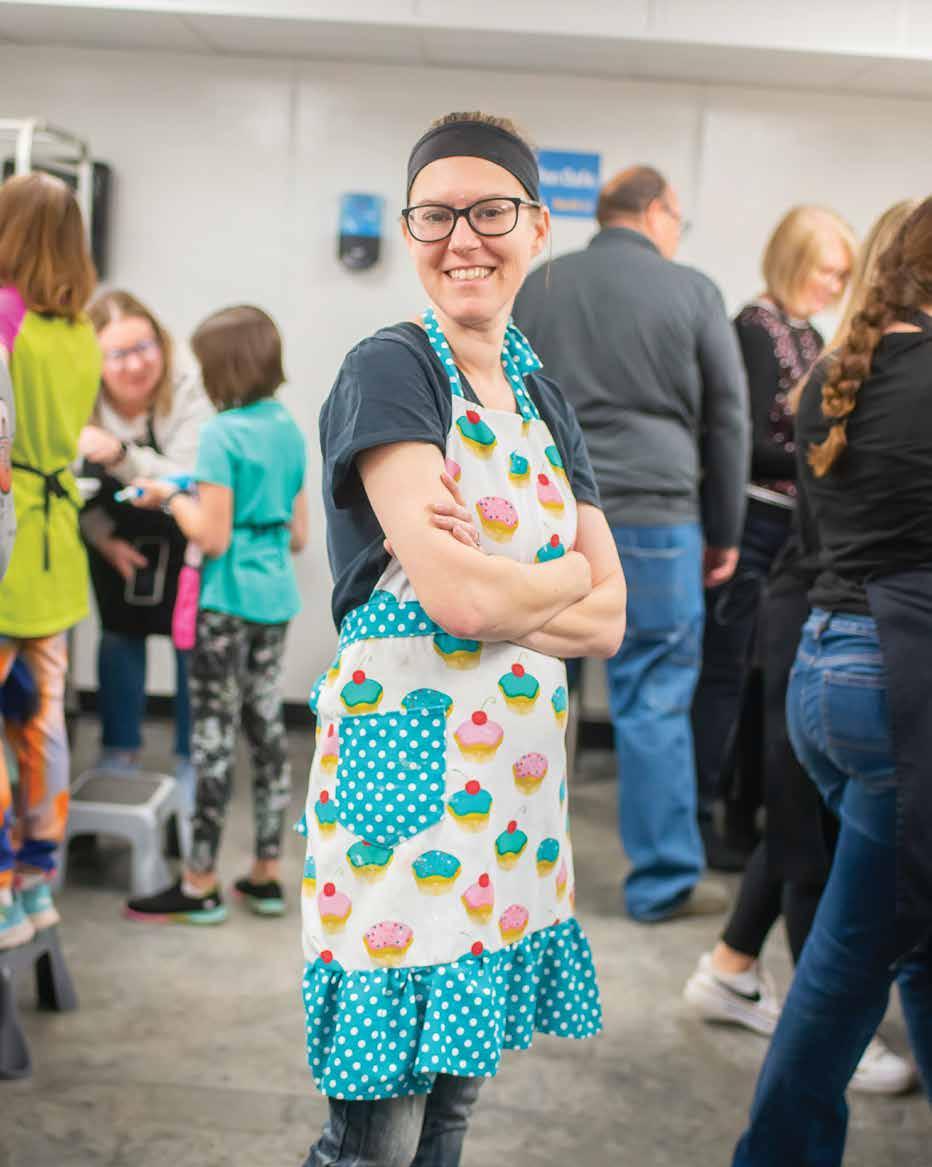
In 2014, Ashley Nichols used her self-taught kitchen expertise and founded Back 2 Basics Cooking, a program that o ers beginning-level cooking classes for ages 3 and up.

“I didn’t really know what I was doing back then,” Ashley says, laughing. “I had a lot of food allergies, so I did a lot of home cooking for my family — always enjoyed it. I decided I wanted to share my love of cooking with adults and kids alike.”
Initially, Ashley says she had to move the location of her cooking school around using whatever kitchen space she could nd.
“I have been in a lot of kitchens in the Columbia area over the years, including a cabinet shop showroom kitchen,” she says.
In 2022, Back 2 Basics Cooking nally found a home at the CoMo Cooks Shared Kitchen, a community-driven culinary space in Columbia that provides a fully equipped kitchen for individuals and businesses to use on a shared basis.
Located at 14 E. Business Loop 70, CoMo Cooks is designed to meet the needs of local food entre-
preneurs, caterers, bakers, and other culinary enthusiasts who require a professional kitchen to prepare their products or host cooking events.
e space o ers a fully equipped, health department-certi ed commercial kitchen with modern appliances, ample workspace, and storage facilities that can be rented at a cost-e ective tiered billing plan.
In addition to the physical facilities, CoMo Cooks Shared Kitchen fosters a collaborative and supportive environment where members can connect, network, and learn from each other. It serves as a hub for culinary creativity and entrepreneurship, enabling food enthusiasts to pursue their passions and grow their businesses.
e CoMo Cooks kitchen is a gleaming collection of stainless-steel appliances and countertops, all of it super-sized for commercial production.
“For most of my students, it’s the rst chance they’ve had to experience a commercial kitchen,” Ashley says as she describes the excitement her rst-time students often feel.
Ashley says her cooking classes are focused on teaching fundamental kitchen skills to both kids and adults who are interested in learning or improving their culinary abilities. e hands-on cooking classes emphasize the basics of cooking such as knife skills, cooking techniques, and meal planning. ese classes are designed for beginners or those looking to refresh their culinary skills and gain con dence in the kitchen.
“It is so exciting to see an adult or child trying something new in the kitchen and nding success,” says Ashley.
Back 2 Basics o ers nine di erent cooking classes, each with its own targeted skills, age range, and cost, plus birthday party packages and a kids' cooking camp during the summer.

All food, cooking utensils, aprons, and everything needed for the class is included and participants receive a copy of all recipes to take home. Ashley says another perk is that participants are not required to clean up after the class — it is taken care of.
“Unlike many activities geared toward children, cooking is a skill that any child can bene t from for the rest of their life," she explains.
In the Mini Chef Class (ages 3-6), kids learn basic food prep skills as they prepare a dish, such as apple cinnamon mu ns or scrambled eggs, or learn to decorate cupcakes.
During the Junior Knife Skills 101 (ages 7-15), Ashley introduces participants to the basics of using a knife safely and correctly. Students start the class with a child-safe knife and end the class safely and e ectively using a chef's knife.
Ashley remembers a mom who was so nervous about her middle school daughter using a knife that she had to leave the class and come back, only to nd that she had done amazingly well.
“It can be so hard to get out of the way of our kids because of our own anxieties, but when we can, they usually thrive," she says. "At least that has been my experience, not only with my students but also with my own children.”
e Kids Culinary Cooking Club (ages 7-15) class allows each junior chef to prepare and enjoy a two-
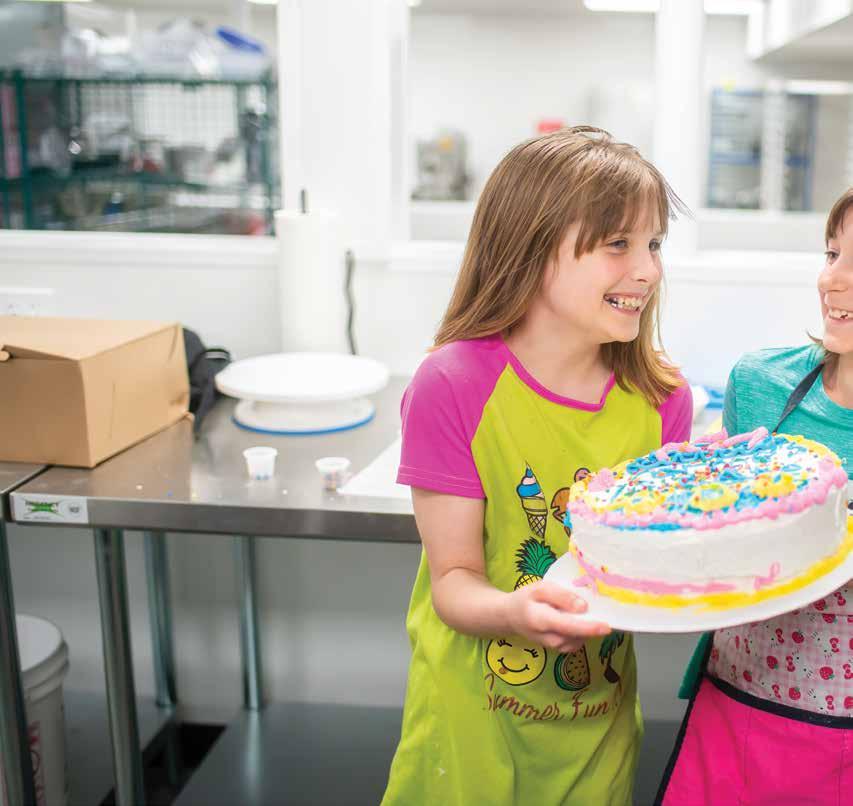
“It can be so hard to get out of the way of our kids because of our own anxieties, but when we can, they usually thrive.”
Ashley Nichols
course meal, while building a solid foundation of kitchen knowledge and experience.
Students in the Junior Chefs ‘N Chaperones (ages 7-15) class team up with an accompanying chaperone to cook a full meal, which they will enjoy together afterward — making this the perfect experience for mothers, fathers, grandparents, aunts, uncles, or guardians to join in on the fun.

“ e kids' classes focus on things they can make themselves with minimal supervision. I really love when people tell me that their kids made something at home that they learned in my class,” says Ashley.
Ashley also o ers classes like sushi making and cake decorating that are intended for adults, but kids are welcome if they can work on their own and are accompanied by an adult.


“I was really surprised when I started o ering these classes how many kids were interested in attending,” says Ashley. “But they love it, too.”
e wildly popular Back 2 Basics kids' summer cooking camp is already full for 2023. During the week-long class for 3 and a half hours a day, students learn cooking and baking skills, kitchen sanitation and food safety best practices, and knife skills. Ashley says for summer 2024 she plans to o er more than one session.
“My favorite thing about what I do is probably working with the kids," she adds. " ey teach me as much as I teach them.”
In addition to their regularly scheduled o erings, Back 2 Basics also hosts birthday parties and team building classes for groups. During the birthday party class, eight participants learn to prepare an entree and dessert chosen in advance from a list of options. Ashley says allergy-friendly options are available if requested in advance. You can book any of these classes or purchase a gift certi cate by visiting the Back 2 Basics website or follow them on Facebook to keep up-todate on upcoming classes and events.
Once a month, Back 2 Basics Cooking teams up with Tiny Town Play Café to o er a kids' cooking class at the local play space. Tiny Town o ers child-sized playhouses including a grocery store, a school, an o ce, a house, a vet clinic, and a construction site where kids can go inside, dress up, and partake in imaginative play. You can read more about Tiny Town on page 48 of this issue.
“I am honored to have the opportunity to serve our community in this way," Ashley explains. "I have had some kids that have come since the beginning and are still coming. It is so amazing to watch them continue to grow and the pride they feel when they learn and accomplish new things in the kitchen.”
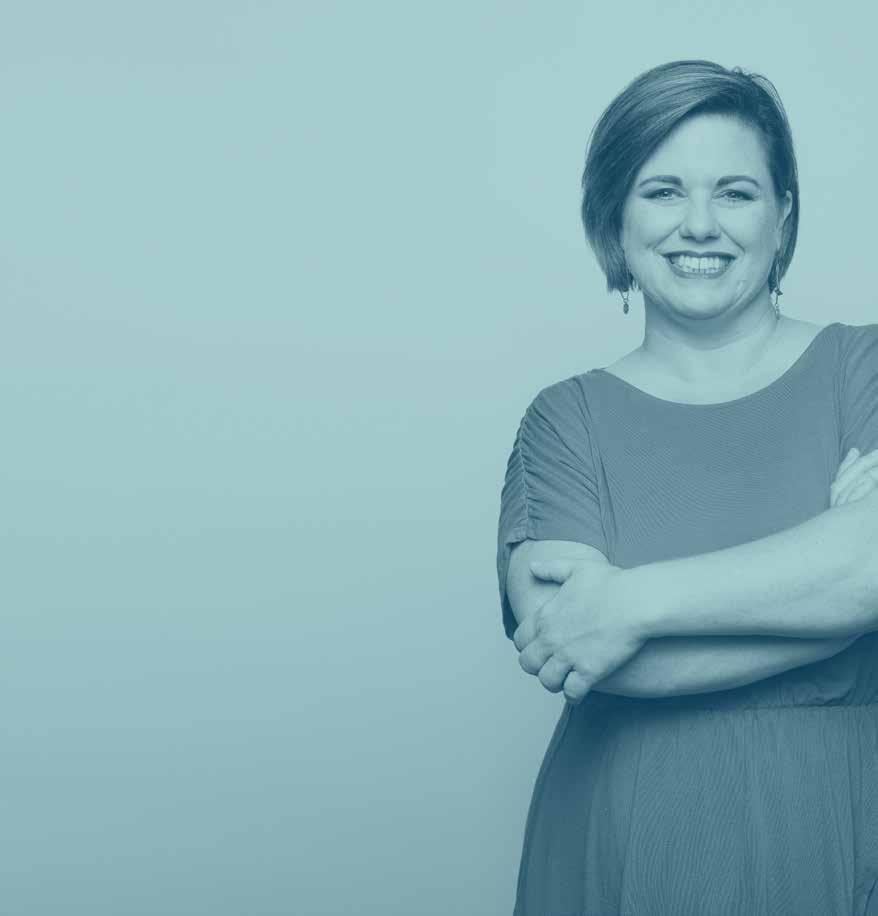




Gentle rivers full of twists and turns, spectacular Ozark scenery, and phenomenal fishing make for a fantastic outdoor adventure! But that only scratches the surface of all Pulaski County offers. Fill up on tales as old as time at our historic military and Route 66 stops. Test your skills at archery, golf, indoor shooting, and more. Grab delicious eats and treats at our unique diners. Then do it all again as you work your way through our day-after-day adventures.


There’s a good chance you have heard of the Boys & Girls Clubs of America, well-known nationally for its popular after-school programs for kids in elementary through high school. You may even remember the series of national commercials club alumnus Denzel Washington did in the late 1990s to early 2000s.
Boys and Girls Clubs of Columbia is one of more than 3,800 club chapters nationwide that serve around 3.6 million youth annually. e organization got its start in 1860 by four women in Connecticut who believed that boys roaming the streets should have something better to do; they started a club that focused on character development, improving behavior, and setting personal goals. In 1906, several other boys’ clubs decided to team up to create the Federated Boys Clubs in Boston, which started a national movement.
e organization became Boys Clubs of America in 1931. It wasn’t until 1990 that girls were added to the name.
e Columbia chapter was formed in 1997, in a small house, serving about 10 to 15 kids. e mission of “Boys and Girls Clubs of Columbia is a safe place to learn and grow — all while having fun. It is the place where great futures are started each and every day” has not changed, though the number of children served has grown exponentially.
BGCC serves around 700 youth annually through its clubhouse at 1200 North 7th Street and in-school locations at Alpha Hart Lewis, Blue Ridge, Derby Ridge,
and Battle elementary schools. e club served around 700 youth during the 20202021 school year, which included serving more than 91,000 meals and providing more than 57,000 hours of in-person program hours, and 14,500 virtual program hours. Roughly 93 percent of youth members are from single-parent homes, and 80 percent of members qualify for free and reduced-price school meals.
e BGCC marked its 25th anniversary in 2022 and the organization chose to mark the milestone in an unusual way: With a complete organizational restructure.
“[We celebrated] internally. Twenty- ve years is a great accomplishment, but admittedly, we’re still dealing with post-pandemic challenges, so it’s been a year of transition,” explains BGCC CEO Abigail Anderson. “Our club decided to basically do an organizational reset.”
Abigail says the goal of the restructuring was to ensure equitable access to high-quality programming for all youth.
“Everything changed, from job descriptions to reporting model to sta ng model. We went from a stationary sta ng model to a hybrid,” Abigail explains. “We have some sta who provide stability in terms of relationships with kids, think of like, a homeroom teacher; we have one of those sta at each of our sites, and then we invite traveling educators who provide an activity at one site one day, then go to the other sites on other days to provide the same activity.”
Abigail started in January 2022, so she has been a big part of the change. She previously was with the American Red Cross and has lived in Columbia for 15 years.
“So, did we celebrate 25 years?” she asked. “Yes, internally, but we also rolled up our sleeves and asked how the next 25 years will make a di erence.”
While youth ages 5 through 17 attend BGCC from 3 to 7 p.m., the Club o ers so much more than your average after-school program. For example, did you know it o ers programming in six core areas? Character and leadership; sports and recreation; arts and expression; health and wellness; academics and mentorship; and social and emotional learning support. BGCC also o ers summer camp and spring break programming.
“ e club is where kids come to be kids, to grow and learn, and to receive positive mentorship,” Abigail explains. “We enable all youth to be successful. We present opportunity, whether that’s through leadership or academic achievement, we prepare kids for life [in ways] that go beyond the core curriculum in the schools and extend into life.”
Examples of that include teaching the value of giving back to their community or voting, respecting each other, and knowing how to communicate and solve problems.
“ ose are things that can extend to every single kiddo in town,” she adds. “ ey don’t have to be a part of any certain demographic. And kids learn in ways that they don’t really know they’re learning.
at’s how we make a di erence, by preparing kids to be successful in life.”
Abigail says the club starts daily around 3 p.m. and goes until 7 p.m. at all ve locations. Youth get a hot meal, mentorship, time with peers, and structured time to do things like homework. She says the club employs youth development o cers who work at every site and are trained on developmental milestones, and social and emotional support. She notes that the
development o cers are positive youth mentors in real-time, providing one-onone attention to help the youth through problem-solving and managing stress.
“We know that this works,” Abigail says. “ ere’s a lot of evidence that proves that if a kid can self-regulate and walk through those self-re ections, we’re nding less gun violence, less participation in gangs, and less dropping out of school, fewer st ghts — we’re measuring all of those things ... ”
e club relies on volunteers and paid tutors. Teacher liaisons — daytime teachers who work for the club for a couple of hours a week — are also involved, helping communicate with the after-school sta about what’s going on in school and where a student may need additional help.
Membership costs just $5 per year per child, plus additional fees for programs, based on a sliding scale. At least 80 percent of BGCC members qualify to pay just the annual $5 fee.
e main clubhouse on North 7th Street boasts some attractive features sure to capture the interest of teens, like a recording studio, a performing arts stage, two basketball gymnasiums, a culinary kitchen, and an art gallery.
“We have a recording studio where kids learn how to nd their voice. ey don’t have to be talented at singing or spouting o poetry,” Abigail says. “[Using the studio is about] identifying with their feelings and being able to put words to them. ey learn to nd their voice and how to use it, and that’s powerful.”
Helping youth to nd their voice, whether via the performing arts stage, the art gallery, the basketball court, or in the kitchen, is a critical part of the club mission, as this helps them to think critically, set boundaries, and gain con dence.
e programming shows evidence of being e ective. Following the spring break program at the club, parents told Abigail that when they came to pick up their kids at the end of the day, the kids didn’t want to go home because they were having so much fun.
“What we’re really focusing on this year is getting that programming out. We’re taking some of the recording equipment out to the schools and doing those fun activities there,” she says. “Building the infrastructure that allows us to do that.”
Abigail says that because so many members are from single-parent homes, many youths lack access to after-school transportation to the clubhouse where all the “really cool stu ” is. Taking it to the schools makes access more equitable. Abigail says that’s important because the needs of youth have changed dramatically post-pandemic. She says the achievement gaps that existed before COVID only grew wider during the pandemic, which brought to light some inequities in the accessibility of the programs, which BGCC is now addressing.
“ e other half of our mission is to serve those who need it most,” Abigail says.
To that end, the club is planning on running a capital campaign in the next ve to seven years to expand its footprint in the next seven to 10 years, with sites set on building a clubhouse at Brown Station and Rangeline.
Abigail says decisions like these don’t happen in a vacuum. e club is counting on community feedback about the ever-changing needs of local youth. And she encourages people to get involved. e club is actively looking for tutors and positive youth mentors; volunteer opportunities start with a commitment of just one hour a week.
“We’re listening — to the community, the parents, teachers, administrators — about the needs of our youth,” she explains, “because they’ve changed a whole lot since the pandemic.”
“We’re listening — to the community, the parents, teachers, administrators — about the needs of our youth because they’ve changed a whole lot since the pandemic.”


Your business is your passion. Sure, there are days that aren’t as great as others, but you keep pushing forward. You deserve a bank that backs your passion – one that asks “What’s next?” instead of “What for?” Our bankers are here to do our part to make your dream a reality. Whether you’re just getting started or if you want to take it to the next level, we’re the bank of making it happen. We’re The Bank of Missouri.
Let’s get started with a banker near you.

To understand the charming City Garden School, you must rst understand its background and origination. e City Garden School is inspired by Waldorf Education, which is based upon the thoughts of Austrian philosopher Rudolf Steiner, dating back over 100 years ago. During the turbulent years of the First World War, he dreamed of better ways.
e CGS website describes that genesis: “Austrian philosopher Rudolf Steiner worked with factory owner Emil Molt to create the rst Waldorf School in Stuttgart, Germany, with the goal of educating children to be clear-thinking, compassionate, and conscientious adults that could look at the world in complex ways rather than descend into war. Steiner achieved this by creating a pedagogy centered around reverence for and deep observation of how we, as human beings, naturally develop.”
“It’s this method of education that really embodies teaching students through their heads, their hearts, and their hands,” says Jordan Johnson, head of school. “ at recognizes that students are whole people and that we can’t educate them fully if we’re only focused on academics. And so, we try to make sure that we’re honoring their bodies’ needs for movement and art and beauty and spirituality.”
City Garden School was founded in June 2013 by a small group of parents who wanted a school inspired by Waldorf education for their elementary students.
“It started as a small kind of homeschool enrichment group for students who were graduating from some of the Waldorf-inspired preschools and wanting to continue that type of education,” says Jordan.

What started at 12 students in grades one through three has grown into 63 students in kindergarten through grade six.

“We rented two rooms in Calvary Episcopal Church in downtown Columbia, and we visited Peace Park for recess,” the CGS website explains. “Every Friday, parent drivers would help bring our students to a nature area in the county. We visited ree Creeks Conservation Area, Rockbridge State Park, Pinnacles, and local city parks as well. is Outdoor Friday program continued for many years.”
With the onset of COVID, City Garden School met the education crisis with outdoor education. According to its website, it was in the 2020-2021 school year that the school rst rented Camp Takimina, returning to the location at Calvary Episcopal Church in the deepest winter months. CGS saw a rapid increase in its student body, almost doubling to around 35 to 40 students. Outdoor Fridays were discontinued because the school was outdoors all week.
“Nature is kind of a building block to Waldorf as well,” Jordan explains. “ e curriculum, especially in the younger grades, really aligns with the natural rhythm of nature. And in our classrooms, we use natural materials that are beautiful and homelike and calm — no jarring colors and sounds and things like that.”
e City Garden School goes above and beyond in many ways. When asked what sets the school apart from others, Jordan’s answer came easily.
“I think it’s really our focus on a holistic approach. at’s kind of a buzzword in education. Like teaching the whole child,” she says. “ is type of education has been around for 100 years. e whole focus is creating this natural curiosity in students and nurturing them fully. And the rigorous curriculum that we bring to them as well.”
Apart from the regular school year curriculum, City Garden School o ers summer nature camps. e summer camps are hosted at Rock Bridge Memorial State Park. ere are two sessions o ered, starting in early June through the end of July. Each session is from 8:30 a.m. to 1 p.m., designed for incoming rst graders through sixth grade.
e City Garden School invites anyone who is interested in the school to schedule a tour or attend an open house. ere is an application and interview process to make sure CGS is a perfect t for everyone involved. e City Garden School o ers tuition assistance in the form of tiered tuition, which is a multi-tiered model allowing families to choose a monthly tuition rate with a corresponding volunteer hour requirement.
“ at’s kind of a unique thing that we do. We really want this type of education to be available for every family, no matter what their nancial situation may be,” Jordan says. “And so, we do have a pretty low starting tuition but even from there, we have di erent tiers. e more contribution hours you can donate up to 10 hours, the lower your tuition will be.”
With the continued and predicted growth, City Garden School is quickly outgrowing its current space.


“We are looking at the feasibility of a capital campaign and one of our families has purchased some land and is holding that for us,” Jordan says. “ is is a beautiful 11 acres o Mexico Gravel. Now we’re in the phase of guring out how to raise the money to pay for the buildings.”
Along with a new building, CGS hopes to be become a K-8 school by the 20242025 school year. e plan is to add an additional grade for the next two school years. CGS is also nishing up the accreditation process and anticipates being accredited in June.
Tiny Town Play Café offers a joyful experience for the young and young-at-heart.





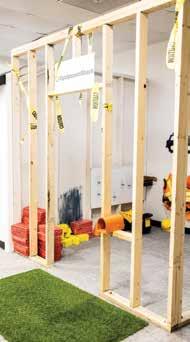



 BY LAUREN SABLE FREIMAN PHOTOS BY MADI GREEN
BY LAUREN SABLE FREIMAN PHOTOS BY MADI GREEN
After driving three hours with young kids in tow, Jayci Gesling was looking forward to meeting up with an old college friend, grabbing a cup of coffee, and relaxing at an indoor play space, catching up while the kids played happily nearby. Everything was going according to plan until she walked into the play space, only to learn that she and her friend could not bring their much-needed and highly anticipated co ee inside.
“ at started the wheels spinning,” Jayci says. “I knew that you could have an indoor play area where you could have co ee, and you could keep it clean.”

While that idea remained in the back of her mind, life was forging ahead at full speed for the teacher-turned-stay-at-home mom. en, the COVID-19 pandemic hit.
e parks and the playgrounds closed, and everything stopped.
“Every place we found joy, we couldn’t go anymore,” Jayci says. “All the options for having fun with your kids and enjoying them as toddlers were over, and that was heartbreaking for me.”
In the winter of 2020, Jayci took a course through the Missouri Women’s Business Center, where she gained new knowledge, and a renewed interest in taking
the idea in the back of her head — and bringing it to life.
“It got to a point where I talked about it and thought about it and dreamed about it for a year and a half,” Jayci says. “I realized I could do it and fail or not do it and wish I would have. We decided as a family that we were going to take a big leap.”
On May 21, 2022, Tiny Town Play Café opened on E. Nifong Boulevard. With 3,600 square feet of space divided into a variety of areas, Tiny Town is a place for families to play, learn, grow, and connect, just as Jayci had envisioned.

“We have about 1,200 square feet of play space with playhouses, a baby area with soft play mats and a ball pit, train tables, block tables, and things on the walls,” Jayci says. “ ere is a nursing room, quiet sensory room, and a classroom for music classes and parties, and the other half of the space is a café.”
e main section of Tiny Town is divided into di erent play areas, hand built by Jayci, her brother, and many other friends.
“ e whole idea is that it would resemble mid-Missouri,” Jayci says. “ is isn’t a franchise, and I wanted this to be a small local joint.”
With some help from the Anderson Homes design team, Jayci and her team of helpers constructed a play city, complete with a vet clinic, a grocery store, a school, an o ce, a house, and a construction site.

“A lot of our playhouses are sponsored, so the sponsor gets some advertising and their name on the little building,” Jayci says. “Angell & Co Insurance is the o ce sponsor, CountryVets is the sponsor of our vet clinic, EquipmentShare is the construction site sponsor, and Anderson Homes sponsored a playhouse.”
As a mom of three kids, Jayci says she was very focused on some key concerns — cleanliness, safety, and a positive experience. Tiny Town’s policies and procedures are focused on supporting a joyful play experience for all guests.

ough the cafe doesn’t attract walk-in tra c, it is a welcome service for parents and caregivers. With local Camacho coffee, lattes, and espresso, pastries sourced


from local bakers like Range Free and e Blakery, and snacks and drinks for kids, the café provides a respite for adults and a place for kids to refuel between play.


“Parents can take their co ee and sit and you can be close to your child, see them playing and not have to run around and chase them,” Jayci says. “Line of site was important when we designed the building. I wanted parents to feel like they didn’t have to chase people around.”

e day is divided into three play sessions — 8 to 10 a.m., 10:30 a.m. to 12:30 p.m., and 1 to 3 p.m. — with 25 spots available for each. In the time between each session, the sta is focused on cleaning and disinfecting the play area for the next group.
“ at’s part of the business with the indoor play industry,” Jayci says. “Kids are germy, they get sick, they’re building immunity. During those breaks, we are wiping down the tables, cubbies, and toys.”
Jayci says Tiny Town’s clientele bene ts from the two-hour time slot, as that’s about the length of time young kids can play happily before nap or snack time.

“ ey are playing happily for two hours, we ash the lights and give them a time warning,” Jayci says. “We give them stickers and then help them out the door happily. If you stretch it too long, they get hungry, tired, and upset and leave unhappily.”
Frequent visitors can choose from monthly or annual membership options that allow them free, unlimited open play. Some members will sign up for two play slots, sit in the café for a snack while enjoying a coloring sheet or Play-Doh tray, then return for a second play session. Tiny Town
also o ers a homeschool membership, giving homeschooling families unlimited admission to afternoon play sessions on weekdays.

“We have about 85 members, and it is such a joy to see these families grow up and to see their kids get bigger,” Jayci says. “We know their kids’ names and greet them at the door.”

Tiny Town also hosts birthday parties geared towards kids up to age 6, frequent special events like character visits, and classes like cooking, sensory exploration, and music. Jayci says she hopes to expand her class offerings to include a baby sign language class and other classes that would appeal to young families.
While the Gesling family calls Centralia home, Jayci’s research revealed that there wasn’t a market for a business like Tiny Town in Centralia. Columbia, however, was a perfect t.
“I’m not from Columbia so I was hesitant to jump into the business world because it was so out of my comfort zone," Jayci says. “But I’ve been superbly welcomed by people who I thought would be strangers, but ended up being good friends and acquaintances looking to support me and small business.”

A person you know.

Job Point, Columbia Career Center, and Columbia CARE prep residents for employment.
BY JODIE JACKSON JRYoung people who don’t have a plan or a yearning to go to college: Listen up. It’s possible to nd a career that will not require a college degree. In fact, says Ron Schmidt, program director of Columbia CARE, there are good, high-paying jobs “just begging to be lled.”


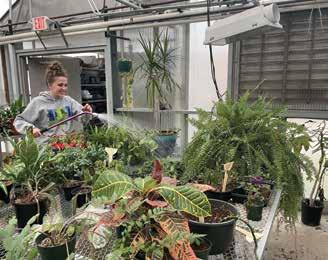
“If you get the certi cation to be an equipment operator, you can write your own ticket,” Ron says. “We’re trying to get people to start seeing that.”

An equipment operator certi cation program could be up and running within the next year as part of the Career Awareness Related Experience — or CARE program — that has been part of the Columbia Parks and Recreation Department since 1982. CARE currently hires around 150 Columbia youths ages 14 to 20 each summer, placing them at businesses where they gain real-world, hands-on work experience while getting paid. All of the wages are paid by CARE, though Ron likes to see the businesses treat the workers like one of the business’s own employees.
He emphasizes that all worker liability — worker's comp insurance, for instance — is the city’s responsibility.
e equipment operator training would be an expansion of CARE and would meet an urgent need the city is experiencing with its own workforce. For now, CARE workers are placed at local restaurants, daycare facilities, retail shops, hospitals, local parks, and other locations. CARE is operated from the Armory Sports and Recreation Center at 701 East Ash St.
Just don’t get the notion that Ron eschews a college education or a ful lling degree program. After all, he has a bachelor’s and a master’s degree, and his children have multiple degrees.
“It’s a wonderful way to go,” he says. “But it’s not for everybody.”
Some Columbia CARE trainees do end up going to college. Some have waded
into the world of entrepreneurship. Others have stayed with their summer work site — as many as a quarter of the summer workers will be o ered employment when their eight-week CARE stint is over. It’s not uncommon to nd out that a few of the CARE workers are still at the same job 20 or 30 years later.
Ron recently oversaw the hiring of 110 teens from a pool of more than 300 applicants. ( e application deadline was Feb. 28.) A paid internship program with the city will add a few dozen more workers. Based on the minimum wage, which has grown while the CARE budget has not increased, the program hired as many as 250 teens 10 years ago. at number is now roughly 150.
Some workers will return for a second or third time to the CARE summer program. Even if they do not enter the eld or industry where they are placed, the experience is invaluable, Ron says.
“ ey are going to learn hard skills at their worksite,” he explains. “But to be successful, it’s the ‘soft skills’ — learning how to show up on time, how to communicate, the work ethic, hundreds of di erent things. If we improve your soft skills over the summer, you’re going to be more e ective the rest of your life.”
e soft skills factor is also front-andcenter at Job Point, which helps individuals get training and nd employment.
“Soft skills are a much bigger point of emphasis,” says Job Point President and CEO Steve Smith. He notes that it’s not uncommon to hear that an employer might have o ered a job interview to a half-dozen or more applicants, “and they’re lucky if two or three will show up for the interview.”
And those that do show up? “ ey’re likely going to get a job,” he says.
e focus on soft skills is especially crucial since the pandemic, Steve adds. Now in the post-COVID hiring landscape, many employers are “much more open minded” to hire workers who do not have either formal training or a college degree. He emphasized that conclusion was his opinion, not an o cial Job Point stance.
“If they have people that will show up and halfway try to get along, they’ll train them in what they need to know,” he adds.
It’s the “get along” factor that seems to elude some unemployed or underemployed residents. Workers who have a good understanding of so-called “soft skills” — knowing how to e ectively communicate, showing up for work on time, not being glued to a smartphone, getting along with others, and showing a solid work ethic — will stand out from other applicants.
e lack of training in soft skills isn’t necessarily a new phenomenon, he says.
“From time to time we see people with lengthy resumes, but they can’t maintain a job for a long period of time, even though some of them have very strong technical capabilities,” Steve explains, saying that scenario often exposes a lack of soft skills. “We have people with three, four-page resumes, but it’s two months, three months, four months on the job. It’s how they interact with people, primarily” that results in lack of longevity with an employer.
Job Point, a fully accredited health and human services nonpro t organization, specializes in preparing individuals to enter the workforce. It serves people with

disabilities, people with de ned economic disadvantages, youths ages 16 and over, people on probation or parole, and unemployed Columbia residents. Headquartered in Columbia, Job Point also has o ces in Boonville and Moberly.
For the scal year ending September 2022, Job Point served 235 people, with job seekers entering employment at an average hourly wage of $13.82. Eighty-four percent of adults maintained employment for at least 90 days. Steve says most workers who reach the 90-day mark will stay with that employer for a longer period.
“We’re not just trying to get people a job,” he says. “We’re trying to get them to maintain employment.”
e placement of 235 people in scal 2022 was just under half the nearly 450 total served in 2019, prior to the COVID pandemic.
“Our numbers were way down during COVID because jobs were abundant,” he says. ose numbers are getting back to normal, thanks to a large database of employers looking for workers and with some individuals seeking more soft skills training.
Steve points to other organizations that help train workers for jobs that don’t always require a college degree. CARE caters to clientele younger than those who seek Job Point services and the Columbia Area Career Center has “some very strong programming” that is geared toward non-traditional trades.
Job Point helps with training for o ce technology positions (ranging from medical to nancial o ces, among others), certi ed nursing assistants, and construction trades, the latter of which begins a new warehouse class in May.

“We’ve talked to several employers who said if [workers] will show up and get training on the equipment, they can go to work,” Steve adds. “If they’ll show up, do some research on the employer they’re applying with, be able to communicate in the interview you understand what the company does show up and be polite — you’ll get a job. at’s a very rare environment.”
Columbia Area Career Center (CACC) at 4203 S. Providence — right next to Rock
Bridge High School — o ers Career Technical Education (CTE) training to better prepare for college or to enter the workforce.
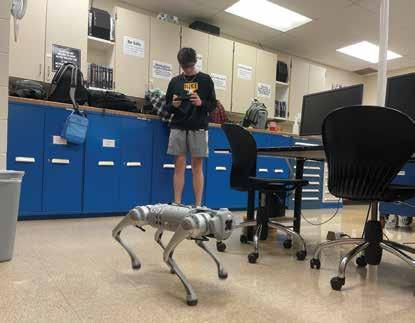

“ ey can go straight to the workforce, get further certi cation, or be more prepared for college,” says Amanda Brown, CACC communication strategist. “We give all our students those three opportunities” if their chosen profession allows those options. Students will receive an industry-recognized credential if they complete the course sequences.
CACC course work is integrated with CPS curriculum. Students still attend regular classes for math, science, and other college preparatory courses. CACC has from 2,500 to 3,000 students each semester and there are also campuses at Hickman and Battle high schools. Students may also be transferred among the three campuses. If a family lives within the CPS boundaries but has a student who attends Tolton Catholic High School, that student may take classes at CACC tuition-free.
e career center also has students from Christian Fellowship School, homeschool families, and Centralia Public School. e Centralia School District pays the cost of its students attending CACC.
“As long as you’re within the district, it is a part of everybody else’s property tax,” Amanda says.
CACC has a sta of 64 sta and administrators.
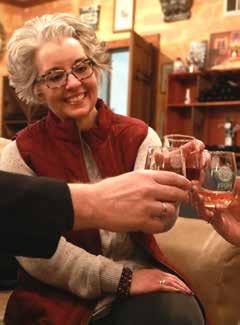
Most career centers throughout the state serve several school districts because they are typically located in more rural areas and drawing from other areas makes more sense.
“We’re just a di erent school district because we encompass so much” due to the district’s size, Amanda adds. Other parts of Boone County have career center connections in other areas. Harrisburg, for instance, transports its students to Moberly, and Ashland High School students attend the career center in Je erson City.
Like Job Point, CACC is “constantly obtaining data,” Amanda says, for reporting on how local, state, and federal funding sources are used. ere are also industry-recognized credentials that must be maintained. e reporting includes a oneyear follow-up survey with students to nd out what career path the student is on. Students who go to work and stay in their eld for a full year are invited to be part of CACC’s advisory board for each industry that is served. Students in the digital media department will help CACC stay current on classroom equipment and teaching techniques.
“It comes full circle,” Amanda says.
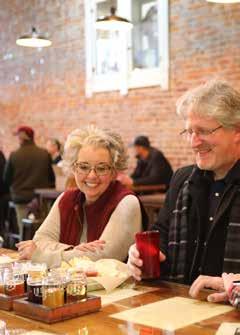
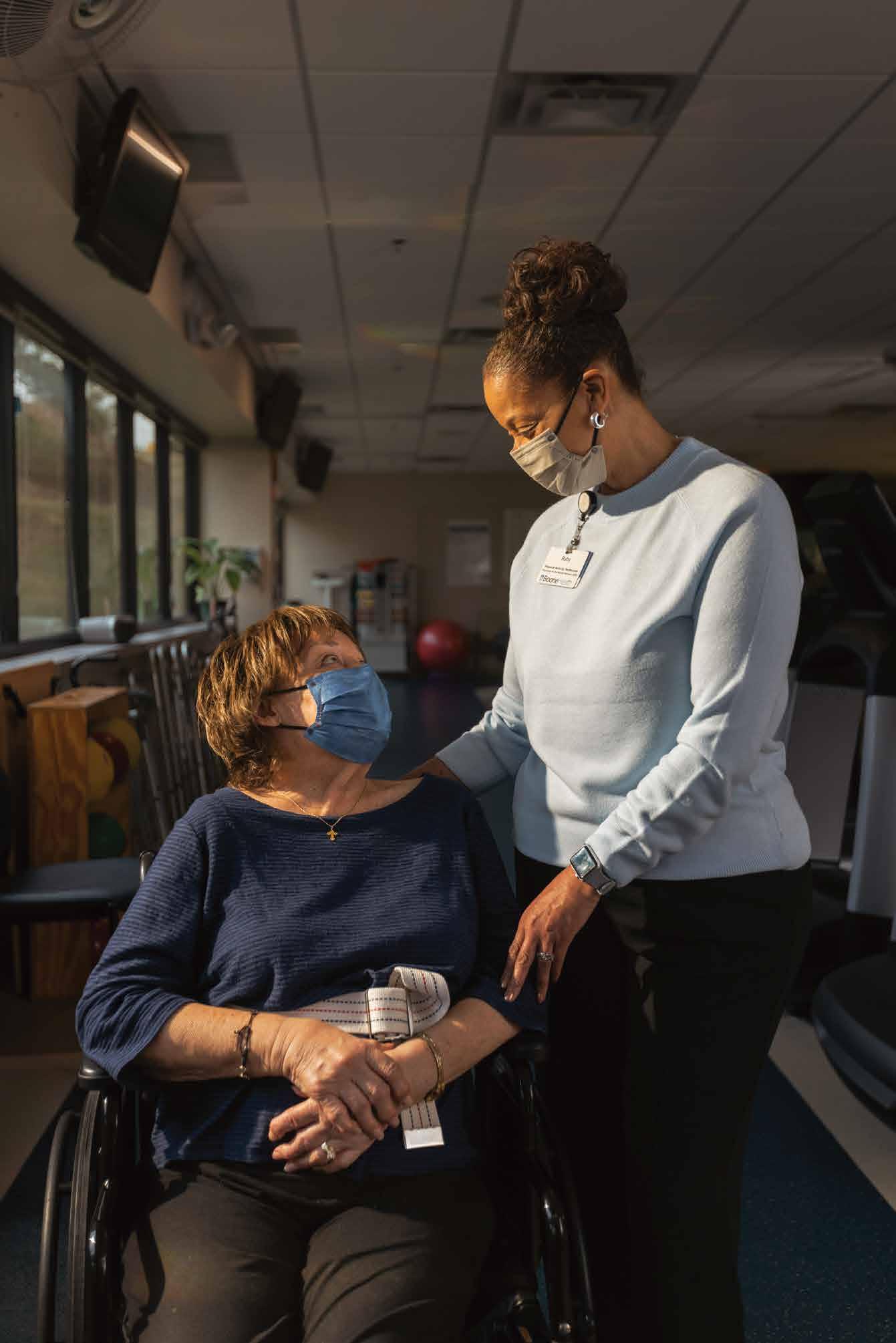

“Specifically, when working with Woodhaven, I think nurses impact our community by assisting in giving our individuals a voice to get them the care they deserve and need. Our whole team at Woodhaven really does well with this. Several times I have received calls from staff saying something just isn’t right with an individual and together we are able to figure out what it may be or get them the care that they need. That’s what makes this job rewarding.”




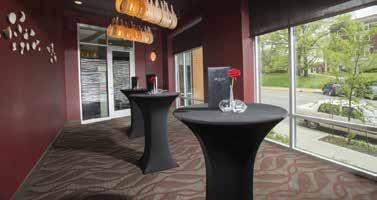
 - LINDSEY KELLY, RN BSN
- LINDSEY KELLY, RN BSN





The Bible tells the story of Old Testament heroes Caleb and Joshua as two of the 12 spies dispatched to Canaan by Moses to see if it was the Promised Land. Ten spies returned, frightened that the people occupying Canaan would slay them in battle. Only Caleb and Joshua believed God would deliver them safely into that land of milk and honey. When everyone else turned away in fear, God allowed only the believers to enter the land.
Dr. Ellis Ingram, M.D., emeritus senior associate dean at the University of Missouri School of Medicine, is a believer. He believes in his faith in God, the power
of science, and the hope of a future made better engaging the curiosity of children for their lifetime. ose tenets compose the roots of CALEB Science Club.
e club sprouted with seeds planted in the mid-1990s when Ellis and Pam Ingram’s youngest children were preteens and Dr. Ingram pondered the question: “How can you create in children a drive to excel?”
e answer lay with CALEB, which stands for Called to Academic & Leadership Excellence and Building character and con dence. e CALEB project has been serving students of all ages in Columbia well for nearly 30 years.
It was also in the mid-90s that medical schools were transitioning to problem-based curricula. Medical students were asked to work together to solve open-ended problems rather than being lectured to by members of the faculty. Ellis had been on the faculty of Mizzou’s medical school for 20 years by that time, and he believed in active learning.
“We gave our two youngest children books on anatomy and invited some of their friends to come over,” Dr. Ingram says. “ ey read them together, asked questions, and started teaching each other what they learned. We wanted to create
The CALEB Science Club shows kids what their future can be by learning alongside Mizzou undergrads and medical school students.

a culture of aggressive learning and academic excellence in which students are not afraid to ask questions.”
In 2001, Dr. Ingram’s late wife, Pam, founded Granny’s House, a nonpro t organization that gives kids a place to gather from 3-6 p.m., Mondays through Fridays. Although Granny’s House is now in a small home on East Worley Street, it occupied two little apartments on Trinity Place for its rst 17 years. It also became the place where more children could gather for CALEB meetings.
Students from fth grade through seniors in high school can participate in interactive programs in science, medicine, and healthcare. CALEB’s mission is to “partner with parents, schools, churches, and universities to assist in nurturing a culture of academic and leadership excellence among students of all disciplines leading to the development of mature adults equipped for a lifetime of discovering new resources from learning.”
at’s a rather robust statement with an extremely ambitious goal. Although parents, schools, churches, and universities play a role, the students themselves bear the major responsibility of leading CALEB.
“We aren’t giving kids childish things,” Dr. Ingram says. “People would say what we were doing was too advanced for them. But they rise to the challenge. Ten-year-olds can learn something at the same time as medical students learn it.”
You might think a relationship with Mizzou was inevitable, given Dr. Ingram’s role at the medical school. When medical students began learning about CALEB, they started coming to meetings. However, the relocation of many of the club’s activities to the Mizzou campus happened somewhat by accident.
e club was scheduled to meet at a local church one Saturday, but a blizzard and a funeral forced the club to look for
another space. Dr. Ingram found a place on Mizzou’s campus and, as he says, “it just felt right,” and it was easy for more medical students to become involved.
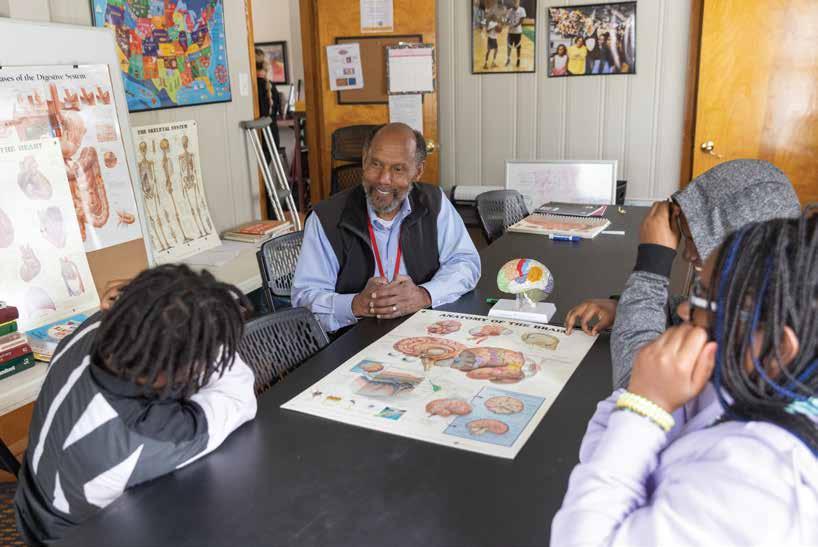
“We try to have an environment where mentorship happens,” Dr. Ingram says. “Everyone learns science and leadership in the process.”
CALEB members can ask medical students to be their mentors. One of those mentors was a student named Laine Young. She’s now Dr. Laine Young-Walk-
er, MD, chair of the Department of Psychiatry and associate dean for student programs at Mizzou medical school.
Dr. Young-Walker met Dr. Ingram when she joined a student group, Blacks in Pursuit of Medicine, when she was a freshman at Mizzou. Dr. Ingram was the group’s adviser and to Dr. Young-Walker, a rare role model as a Black physician. She was the rst in her family to go to college, let alone medical school.
“For me, it was clear that when I met people like Dr. Ingram, who had attained the goal that I wanted, it inspired me to do more. It showed me that I could do it,” she says. “So, knowing that about myself, it’s obvious that younger kids who can see people who make it into med school — and that’s not always easy — know that they can do it.”
Dr. Young-Walker says she didn’t have an easy route to where she is today, admitting that she struggled with a few courses as an undergraduate but still got into med school.
“I enjoyed being able to be authentic with these young kids and showing them that perfection is not required for reaching your goal. It’s determination. It’s working as hard as you can,” she says. “It’s guring out how you can connect with people, learn more, and be the best that you can be, and not necessarily putting yourself up to be what someone else is, is what will get you there.”
“We aren’t giving kids childish things. People would say what we were doing was too advanced for them. But they rise to the challenge. Ten-year-olds can learn something at the same time as medical students learn it.”
So much of CALEB has been about Dr. Ingram’s vision, guidance, and determination. Over the years, he has built partnerships with Columbia Public Schools, Columbia College, Stephens College, and medical schools in Michigan, Texas, and Arizona. In addition, CALEB has started branching out into disciplines other than science and medicine.
“I’d like it to catch on,” Dr. Ingram says. “I want others to think, ‘Let me do this where I am.’”
A Mizzou medical school alumnus now at the University of Texas Southwestern School of Medicine has launched a similar program and christened it the “Ingram Academy.”
“Dr. Ingram came to me and said, ‘I want to make sure this is something that outlives me,’” says Dr. Young-Walker. “I want to make sure there’s a structure and a system in place so CALEB can continue.”
About ve years ago, the medical school began assuming more of the coordination of the club. Dr. Young-Walk-
er says it was a good t since Mizzou already had several pathway programs in place, but nothing that dealt with students as young as fth grade.
Andrea Simmons, senior program manager for Mizzou MedPrep, coordinates the club’s records. She reports that seven academic sessions were held during the current academic year with 56 CALEB participants, and anywhere from seven to 15 undergraduate and medical school mentors participating in each session.
e most recent session on April 1 featured Dr. Annette Joe, MD. She’s a radiologist from Detroit and, not coincidentally, Dr. Ingram’s sister. CALEB students, undergraduates, and medical school students had hands-on experiences with ultrasound techniques. en, CALEB students exhibited projects they had been working on since last fall at the rst-ever Science Fair Showcase.
Dr. Ingram says that kids gain condence because of what they learn and the active-learning environment of CALEB. ey refuse to be limited and nd they aren’t intimidated by advanced science courses anymore.
Once they hear Dr. Young-Walker’s story, kids may gure out they can achieve lofty goals as their mentors have.


Students in at least the fth grade can learn more about CALEB Science Club and register to join from the Granny’s House website. Students can also view virtual session playbacks for some previous programs.
Dr. Ingram remains the heart and soul of CALEB, always seeking feedback and programming that can cultivate kids’ academic and leadership capabilities — often in unexpected ways.
“We like to teach them things people expect they can’t do,” he says. “ at’s how CALEB began, and that’s how it will go on.”












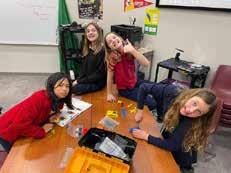

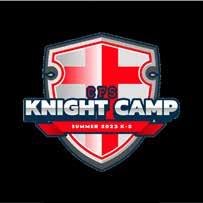
We called on COMO kiddos to answer two very important questions:
1. What do you want to be when you grow up?
2. If you could buy anything you wanted, what would it be?

–
2. A dog
– REESE, AGE 7
(Proud mom here!)
1. I have a few options: artist, teacher, a doctor, or a daycare person.
2. A limo and a mansion
– PARKER, AGE 8
2. A pretty, pretty, pretty, pretty doll
– SADIE, AGE 4
2. Enough food to solve world hunger

– JACE, AGE 10
2. iPhone 14
– HARPER, AGE 9
– GIDEON, AGE 4
2. All the husky dogs
– MAVERICK, AGE 6
2. Enough shirts for everybody
– TUCKER, AGE 7
1. I want to be lots of things. A teacher, a dentist, and a hairstylist. But mostly a dentist.
2. Two dogs, and to change our house into COMO Rocks climbing gym.
– SOPHIA, AGE 7
Incredible engineering defines the 2023 BMW M5 Sedan. From the four-door body and expressive paint finishes to the luxurious interior designed by BMW M, the 2023 BMW M5 Sedan is a dominant force in executive automotive design. A high-performance V8 engine and impeccable power distributionthe BMW M5 outperforms and outruns all others.
